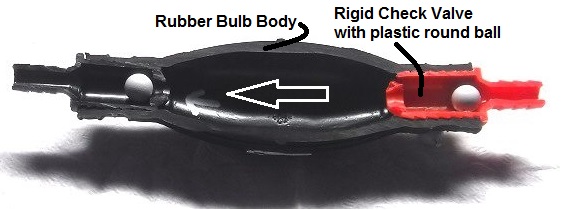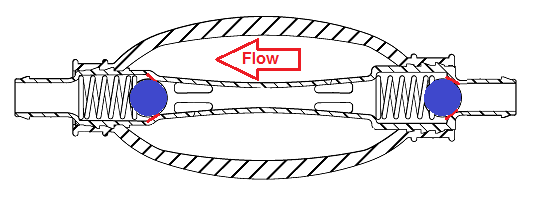TinBoats member Johnny threw together a Primer bulb Primer. This will help those that that are having issues on our forum. This is just a quick article that describes what a Primer bulb does. Hopefully, it can assist you to simplify the troubleshooting process. Once again I want to thank Johnny for taking the time to write up this article for all the forum members and readers.
Exploring the Fuel Primer Bulb
The squeeze type primer bulb is made up of two rigid plastic valve bodies having first and second ends. These two end valves are installed in a flexible rubber fuel impermeable bulb substantially encasing the rigid one-way valve bodies and sealed to the squeeze bulb body with metal hose clamps.
The first and second stage check valves operate in only one direction. The most common squeeze bulb has two free-floating round plastic balls that prevent the back-flow and will only allow fuel to flow in one direction. Hand pumping this squeeze bulb actuates (primes) the fuel flow from the gas tank to the fuel pump on the motor. The two must work harmoniously together to maximize adequate fuel delivery from one end to the other.
There are different versions of the hand squeeze primer bulb. The type described above is called the gravity acting bulb. Meaning that the bulb must hang as vertically as possible to achieve and maintain the one direction flow with minimal back-flow.
Another version pictured below has two springs holding the check valve balls in the sealed position and can operate efficiently positioned in any direction. The arrow on the bulb indicates the direction of fuel flow.
Having any kind of air leak with the fuel line clamps, connectors, or O-rings within the quick disconnects will result in less than a satisfactory operation of the motor. An example of this is a motor runs fine at idle but poorly at high RPMs where more fuel is required to operate properly at high speed. Another fuel delivery issue could be with an old fuel line delaminating on the inside, restricting the flow of fuel.
Dirt and debris will prevent the valve check balls from operating as they were designed to do. This results in poor fuel delivery. It is perfectly safe to cut the metal clamps and carefully remove the plastic check valve bodies for inspection. To reassemble, ensure the valves are in the same operating configuration as they were removed. Use new stainless hose clamps for reassembly. If the rubber squeeze bulb body is overly firm when empty or hard to squeeze with gentle pressure, it may be time to replace it.
If you have any questions or comments feel free to leave a comment below or better yet, reach out to me through the forum.
Johnny
Amazon Link: http://amzn.to/2jCMeBo



Leave a Reply
You must be logged in to post a comment.